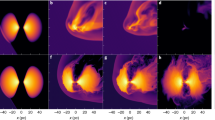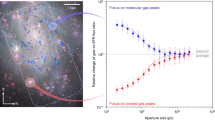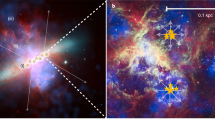Abstract
It is becoming increasingly clear that collisions between galaxies play an important role in galaxy evolution. The ultraluminous infrared galaxies are predominantly powered by enormous star-formation events that are triggered in the last phases of such collisions. These bursts occur just before the galaxies merge to form single elliptical galaxies.
This is a preview of subscription content, access via your institution
Access options
Subscribe to this journal
Receive 51 print issues and online access
$199.00 per year
only $3.90 per issue
Buy this article
- Purchase on Springer Link
- Instant access to full article PDF
Prices may be subject to local taxes which are calculated during checkout




Similar content being viewed by others
References
Zwicky, F. Multiple Galaxies. Ergebnisse der Exakten Naturwissenschaften 29, 344–385 (1956).
Pfleiderer, J. Gravitationseffekte bei der Begegnung zweier Galaxien. Z. Astrophys. 58, 12–22 (1963).
Toomre, A. & Toomre, J. Galactic bridges and tails. Astrophys. J. 178, 623–666 (1972).
de Jong, T.et al. IRAS observations of Shapley–Ames galaxies. Astrophys. J. 278, L67–L70 (1984).
Joseph, R. D., Meikle, W. P. S., Robertson, N. A. & Wright, G. S. Recent star formation in interacting galaxies, I—Evidence from JHKL photometry. Mon. Not. R. Astron. Soc. 209, 111–122 (1984).
Lonsdale, C. J., Persson, S. E. & Matthews, K. Infrared observations of interacting/merging galaxies. Astrophys. J. 287, 95–107 (1984).
Joseph, R. & Wright, G. S. Recent star formation in interacting galaxies, II—Super starburst in merging galaxies. Mon. Not. R. Astron. Soc. 214, 87–95 (1985).
Soifer, B. T., Houck, J. R. & Neugebauer, G. The IRAS view of the extragalactic sky. Annu. Rev. Astron. Astrophys. 25, 187–230 (1987).
Rees, M. Black hole models of Active Galactic Nuclei. Annu. Rev. Astron. Astrophys. 22, 471–506 (1984).
Sanders, D. B. & Mirabel, I. F. Luminous infrared galaxies. Annu. Rev. Astron. Astrophys. 34, 749–792 (1996).
Graham, J. R.et al. The double nucleus of Arp 220 unveiled. Astrophys. J. 354, L5–L8 (1990).
Scoville, N. Z.et al. NICMOS imaging of the nuclei of Arp 220. Astrophys. J. 492, L107–L110 (1998).
Scoville, N. Z., Yun, M. S. & Bryant, P. Arcsecond imaging of the CO emission in the nucleus of Arp 220. Astrophys. J. 484, 702–719 (1997).
Downes, D. & Solomon, P. R. Rotating nuclear disks in ultra-luminous galaxies. Astrophys. J. (in the press).
Smith, H. E., Lonsdale, C. J., Lonsdale, C. J. & Diamond, P. J. Astarburst revealed—luminous radio supernovae in the nuclei of Arp 220. Astrophys. J. 493, L17–L21 (1998).
Sturm, E.et al. ISO-SWS spectroscopy of Arp 220: a highly obscured starburst galaxy. Astron. Astrophys. 315, L133–136 (1996).
Lutz, D.et al. What powers luminous infrared galaxies? Astron. Astrophys. 315, L137–140 (1996).
Genzel, R.et al. What powers ultra-luminous IRAS galaxies? Astrophys. J. 498, 579–605 (1998).
Lutz, D., Spoon, H. W. W., Rigopoulou, D., Moorwood, A. F. M. & Genzel, R. The nature and evolution of ultraluminous infrared galaxies: A mid-infrared spectroscopic survey. Astrophys. J. 505, L103–L107 (1998).
Mihos, J. C. & Hernquist, L. Gas dynamics and starbursts in major mergers. Astrophys. J. 464, 641–663 (1996).
Barnes, J. E. & Hernquist, L. Transformation of galaxies. II. Gasdynamics in merging disk galaxies. Astrophys. J. 471, 115–142 (1996).
Mirabel, I. F.et al. The dark side of star formation in the Antennae galaxies. Astron. Astrophys. 333, L1–L4 (1998).
Sanders, D. B.et al. Ultraluminous infrared galaxies and the origin of quasars. Astrophys. J. 325, 74–91 (1988).
Rigopoulou, D., Lawrence, A. & Rowan-Robinson, M. Multiwavelength energy distributions of ultraluminous IRAS galaxies—I. Submillimetre and X-ray observations. Mon. Not. R. Astron. Soc. 278, 1049–1068 (1996).
Kii, T.et al. in X-ray Imaging and Spectroscopy of Hot Plasmas (eds Makino, F. & Mitsuda, K.) 161 (Univ. Academy Press, Tokyo, (1997)).
Whitmore, B. NASA-STScl press release STScI-PRC97-34a (1997).
Author information
Authors and Affiliations
Rights and permissions
About this article
Cite this article
Genzel, R., Lutz, D. & Tacconi, L. Star formation triggered by galaxy collisions. Nature 395, 859–862 (1998). https://doi.org/10.1038/27597
Issue Date:
DOI: https://doi.org/10.1038/27597
This article is cited by
Comments
By submitting a comment you agree to abide by our Terms and Community Guidelines. If you find something abusive or that does not comply with our terms or guidelines please flag it as inappropriate.



